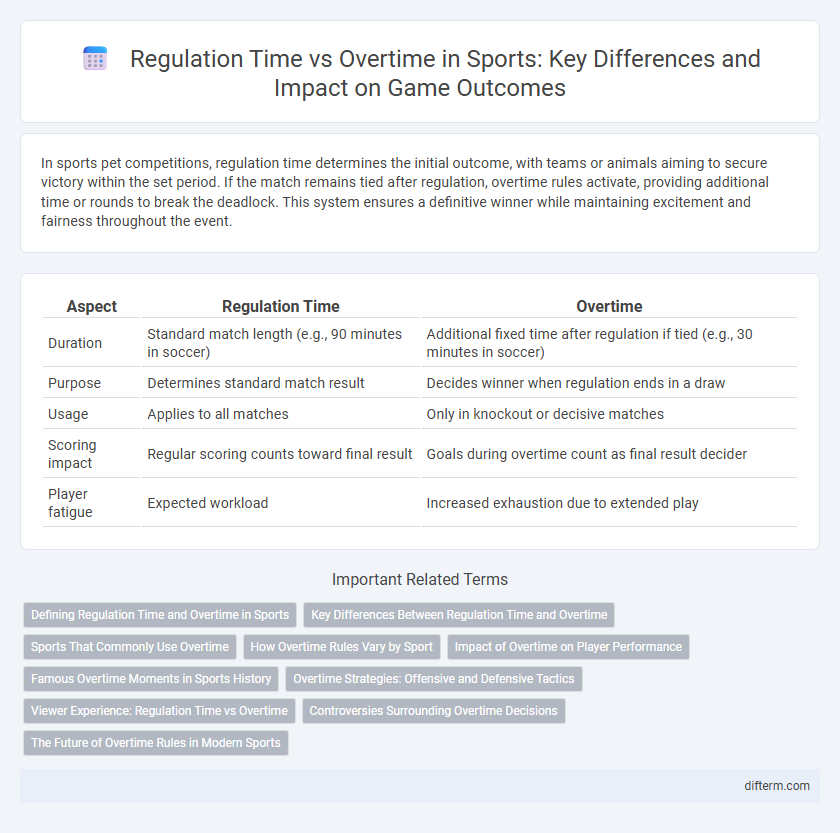In sports pet competitions, regulation time determines the initial outcome, with teams or animals aiming to secure victory within the set period. If the match remains tied after regulation, overtime rules activate, providing additional time or rounds to break the deadlock. This system ensures a definitive winner while maintaining excitement and fairness throughout the event.
Table of Comparison
| Aspect | Regulation Time | Overtime |
|---|---|---|
| Duration | Standard match length (e.g., 90 minutes in soccer) | Additional fixed time after regulation if tied (e.g., 30 minutes in soccer) |
| Purpose | Determines standard match result | Decides winner when regulation ends in a draw |
| Usage | Applies to all matches | Only in knockout or decisive matches |
| Scoring impact | Regular scoring counts toward final result | Goals during overtime count as final result decider |
| Player fatigue | Expected workload | Increased exhaustion due to extended play |
Defining Regulation Time and Overtime in Sports
Regulation time in sports refers to the standard duration set by the rules during which a game or match is played, such as 90 minutes in soccer or 48 minutes in professional basketball. Overtime occurs when the score is tied at the end of regulation time, triggering additional periods to determine a winner, like sudden death in hockey or extra time in soccer. The specific length and format of overtime vary across different sports and leagues, designed to ensure a fair conclusion while maintaining player safety and viewer engagement.
Key Differences Between Regulation Time and Overtime
Regulation time is the standard duration set for a sports game, typically lasting 90 minutes in soccer or 48 minutes in basketball, where the outcome is decided if a winner emerges. Overtime is an extra period played only if the score is tied at the end of regulation, with the objective of breaking the tie through additional gameplay such as sudden death or extended playminutes. Key differences include the fixed length of regulation versus the conditional, often shorter duration of overtime and the higher intensity and strategic urgency in overtime due to the immediate need for a winner.
Sports That Commonly Use Overtime
Sports such as basketball, hockey, and American football commonly implement overtime periods to break ties after regulation time ends. In basketball, a five-minute overtime period is used to determine the winner, while hockey typically employs sudden-death overtime or shootouts in professional leagues. American football often includes timed overtime periods with specific scoring rules to ensure a decisive outcome.
How Overtime Rules Vary by Sport
Overtime rules vary significantly by sport, reflecting the unique pace and scoring structures of each game. In soccer, extra time typically consists of two 15-minute halves followed by a penalty shootout if the tie persists, while basketball employs multiple sudden-death periods or a single fixed extension to break ties. Hockey and football often use sudden-death overtime formats, but the duration and player counts differ, with football using a timed period and hockey sometimes implementing shootouts for regular-season games.
Impact of Overtime on Player Performance
Overtime periods significantly increase player fatigue, leading to decreased performance metrics such as slower reaction times and reduced accuracy. The extended play elevates cardiovascular strain and injury risk, impacting athletes' long-term health and recovery processes. Statistical analyses reveal a notable decline in shooting percentages and defensive efficiency during overtime compared to regulation time.
Famous Overtime Moments in Sports History
In sports, regulation time defines the standard period for completing the game, but iconic moments often unfold in overtime, where the stakes heighten and athletes showcase peak performance under pressure. Famous overtime events such as the 2010 Stanley Cup Final Game 7, the 2017 NBA Finals Game 5, and the "Ice Bowl" NFL Championship highlight dramatic twists that etch themselves into sports history. These instances underscore how overtime serves as a crucible for legendary victories, record-breaking plays, and unforgettable athletic heroics that transcend regulation limits.
Overtime Strategies: Offensive and Defensive Tactics
Overtime strategies in sports emphasize aggressive offensive plays to capitalize on sudden scoring opportunities while maintaining tight defensive formations to prevent opponent breakthroughs. Teams often adapt by increasing play aggression, using high-pressure tactics and strategic time management to exploit fatigue and force errors. Effective communication and situational awareness enable quick adjustments between offensive surges and defensive resilience during the high-stakes overtime period.
Viewer Experience: Regulation Time vs Overtime
Regulation time in sports offers a structured and predictable viewing experience, allowing fans to anticipate the flow and timing of the game. Overtime introduces heightened excitement and unpredictability, often amplifying viewer engagement as teams compete intensely to secure victory within limited extra minutes. The contrast between regulation time's steady pace and overtime's sudden-death scenarios enhances overall spectator satisfaction by balancing routine action with dramatic finishes.
Controversies Surrounding Overtime Decisions
Overtime decisions in sports often spark controversies due to inconsistent application of rules across leagues and sudden-death formats that can unfairly end games on a single play. Critics argue that regulation time should allow more opportunities for decisive outcomes without extending the game, minimizing fatigue and injury risks. Disputes increase when referees' subjective calls during overtime determine winners, highlighting the need for clearer, standardized protocols to enhance fairness and transparency.
The Future of Overtime Rules in Modern Sports
Overtime rules in modern sports are evolving to balance player safety, fan engagement, and competitive fairness, with leagues exploring timed sudden-death periods and integrated video review systems. Emerging technologies and data analytics are driving refined regulations to reduce game duration unpredictability while maintaining excitement. Anticipated changes include standardized overtime formats across international competitions, emphasizing transparency and enhanced athlete performance management.
regulation time vs overtime Infographic

 difterm.com
difterm.com